Cooley Spruce Gall Adelgid (1850-1950 GDD = galls open): Colorado spruce (especially green forms), Sitka and Oriental spruce, and Douglas-fir share this pest’s two host life cycles. Mature adult females lay eggs at the tips of branches. These eggs hatch and the immatures move to new growth and start feeding. The combined feeding and salivary secretions induce the development of a bright green, oval “pineapple” gall on the terminals (as opposed to galls at the base of new growth on Norway spruce from the Eastern spruce gall adelgids). By midsummer, the gall will turn brown and crack open, as the adelgids within mature and emerge as adults. These winged adults migrate to Douglas-fir (or another spruce) and spend the remainder of the summer feeding on the needles, covered with cottony wax.
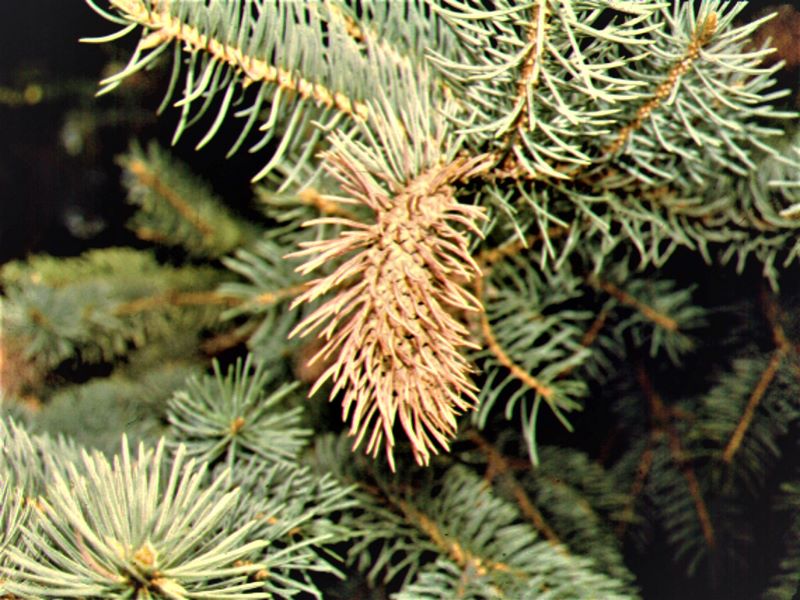
During late July or early August the adult Cooley spruce gall will emerge from the opened brown pineapple shaped galls. (Photo Credit: Steven K. Rettke, Rutgers Coop. Ext.)
Sometimes Douglas-fir is so heavily attacked that needles are spotted, bent, or distorted. Two or more generations can occur on Douglas-fir through the following season (Christmas tree growers will treat Douglas-fir when new growth is 3-4 inches). By next fall another winged generation flies back to spruce and lays eggs for the cycle to repeat itself.
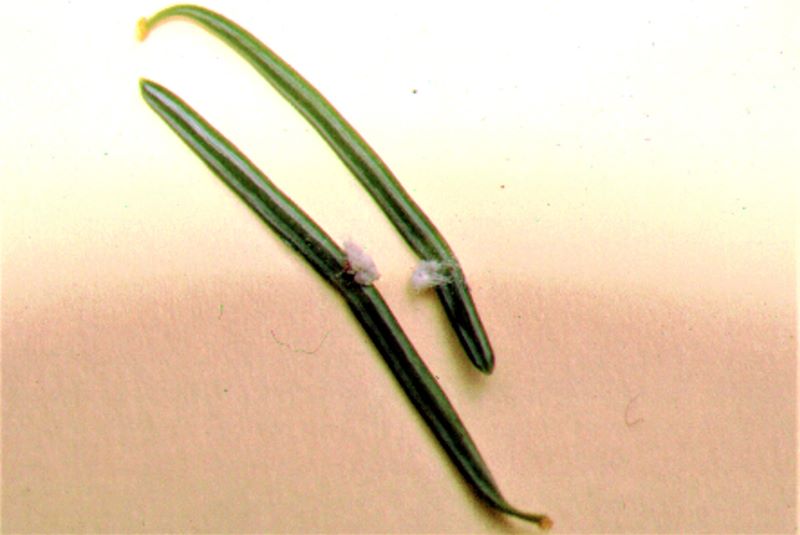
Adelgid nymph within protective cottony wax feeding on Douglas-fir needle. (Photo Credit: Steven K. Rettke, Rutgers Coop. Ext.)
Control by pruning out galls when seen; place sticky traps out in late summer (Douglas-fir or spruce) (1850-1950 GDD) to determine the timing to spray adults with insecticidal soap (+ sticker). Some of the tip “pineapple” galls on spruce have already opened up, and the winged adults have emerged. Except to improve the aesthetic appearance of the trees, there is nothing to be gained by picking off the galls after they have opened. Future control windows will occur during the fall or early spring months, against the overwintering females located at the bases of terminal buds. Some possible treatments include horticultural oil, carbaryl (Sevin), insecticidal soap, or imidacloprid (Merit).
The Christmas Tree Pest Notes Blog for July 2023 also contains a few additional insect pests. Those included below are pine needle scale, pitch mass borer, white pine weevil, & some comments regarding cicada killer wasp predators.
Pine Needle Scale (1290-1917 GDD = 2nd generation): This native armored scale can be found feeding on most needle-bearing conifers. Under heavy infestations (10 live scales per inch of candle shoot) needles turn yellowish, then brown with eventual dieback. From a distance, the foliage may look white to gray. The reddish, second-generation crawlers are active throughout most of July and into August and feed only on needles. The adult female covers are about 1/8 inch long and are white, oyster shell shaped.
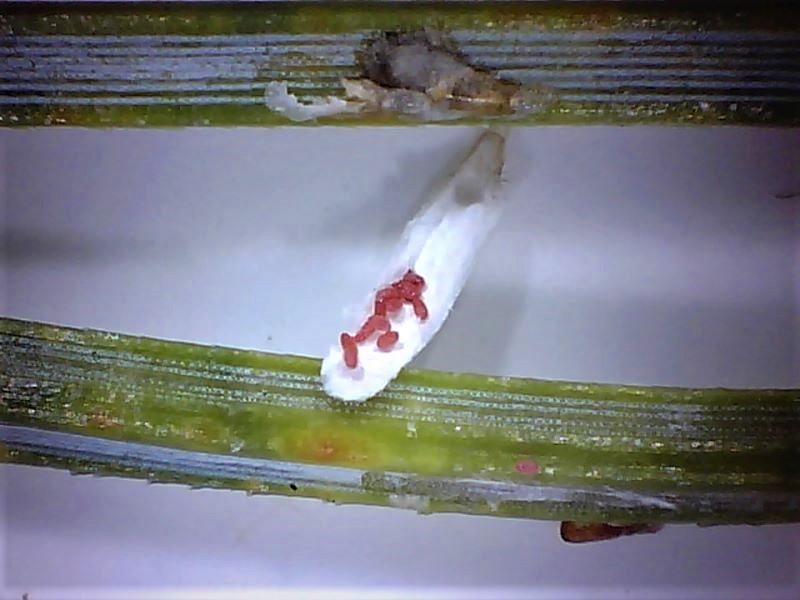
Unhatched pine needle scale eggs are visible when the female cover is turned over. Typically less than a dozen dark red colored eggs will be observed. (Photo Credit: Steven K. Rettke, Rutgers Coop. Ext.)
During July, turn over female covers and examine them with a hand lens to determine if eggs or crawlers are present. Recently hatched active crawlers are flat and reddish in color. These clumsy crawlers move precariously to new parts of the tree in search of suitable needles to feed upon. Settled crawlers then insert hair-like mouthparts into a needle to feed and develop a yellow coloration. It then immediately begins to form a new protective waxy armor. This protective cover is quite thin at first and does not thicken up until after the nymph completes its first molt (after 2 weeks). Therefore, the crawlers will continue to be highly vulnerable to sprays for a couple of weeks.
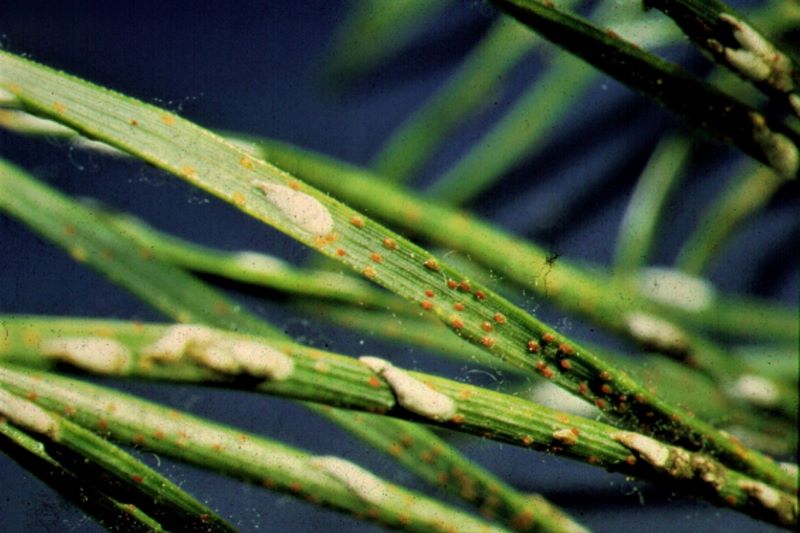
Red colored crawlers from recently hatched pine needle scales are moving away from home. (Photo Credit: Ohio State Coop. Ext.)
Pitch Mass Borers and Lacbalsum Wound Dressing: Pitch Mass Borers are wood-boring caterpillars. As adults, they are called clearwing moths and are in the same family as lilac borers, rhododendron borers, peach tree borers, banded ash borers, dogwood borers, as well as others. Pitch mass borer adults are “on the wing” during the months of June and July and typically deposit eggs near wounds on several different pine and spruce species. The usual pine trees attacked include Austrian, Scotch, and eastern white. The common spruce trees attacked include Norway, white, and Colorado blue.
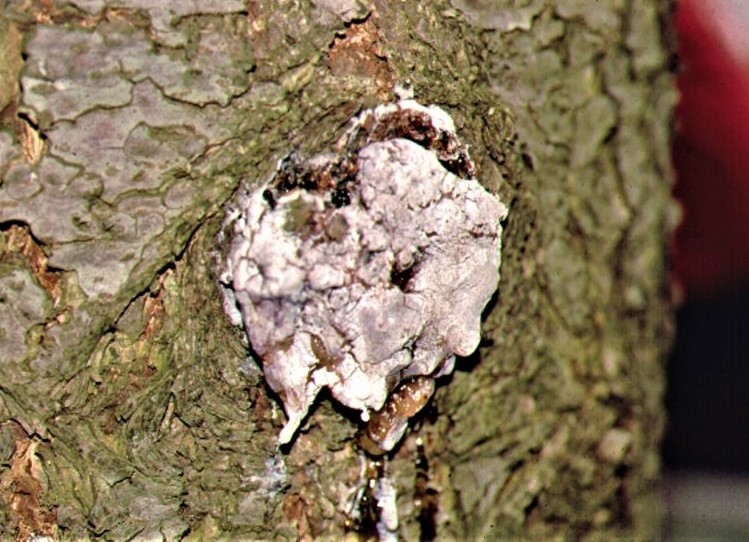
Pitch Mass Borer causing excess sap build up at the original pruning cut. (Photo Credit: Steven K. Rettke, Rutgers Coop. Ext.)
The pitch mass borer is primarily a nuisance in home landscapes or public park areas. Rarely do these borers create a plant health concern by girdling trunks or branches. They will take 2 to 3 years to mature and feed within the inner bark and outer sapwood. However, the shallow tunneling caterpillars do produce copious amounts of pitch. This pitch can potentially rain down on picnic tables, backyard decks, or parked cars.
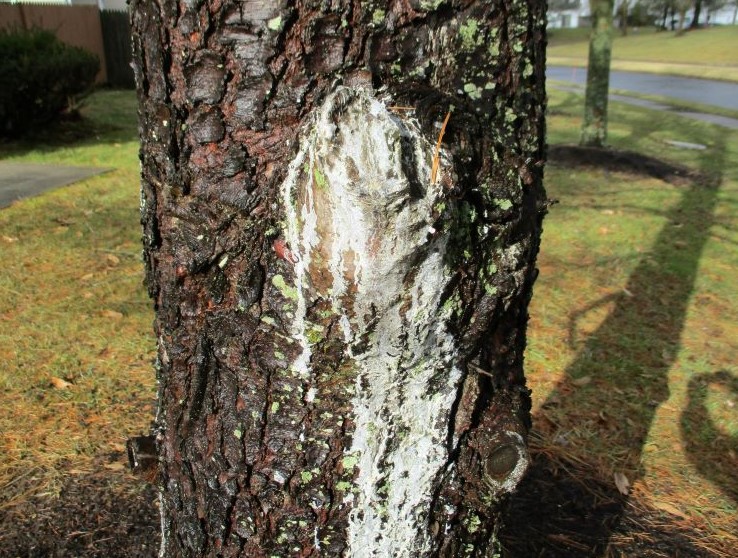
Pitch mass borers causing extreme sap flow down the tree trunk from pruning cut. (Photo Credit: Steven K. Rettke, Rutgers Coop. Ext.)
The pitch mass borer and all clearwing moths require a wound to successfully penetrate and bore into a tree. Therefore, pitch mass borer attacks will often increase after pruning wounds are made (proper pruning cuts included). Several years ago, some studies performed by Cornell University researchers unintentionally showed that pitch mass borer attacks could be reduced on recently pruned pines or spruces by applying a wound dressing. They applied a new generation wound dressing called Lacbalsum (which has a flat gray color) over the fresh pruning cuts. The conifers receiving the wound dressing showed no evidence of pitch mass borer infestations after 2 years. The Lacbalsum acted as a protective barrier and/or did not attract egg deposition. On the other hand, 30% of the conifers not receiving the wound dressing showed evidence of pitch mass borer activity one or two years later (Note: proper experimental protocol was not followed in determining these results).
The Cornell research aimed to determine the health effects on conifers after applying the new Lacbalsum wound dressing. A few decades ago, the late Dr. Alex Shigo made a strong case against the use of some tested wound dressings, demonstrating that they increased wood decay. Although the Lacbalsum wound dressing did not decrease wood decay in the pruning cut areas, the study also showed it did not increase wood decay either. Therefore, the Cornell research indicated that this new generation wound dressing could be safely used to improve the aesthetics after pruning without harming conifer trees.
White Pine Weevil (1200-1400 GDD = 2nd generation adults emerge): Damage from these weevil larvae has been evident for the past couple of weeks in many parts of NJ on Eastern white pine, Norway & Colorado spruce, & also Douglas-fir. The larvae have been feeding within the terminal leaders since mid to late April. When the terminal is heavily infested, larvae feed side by side in a ring encircling the stem. Most of the larvae reach maturity by mid-July & pupate. Adults emerge 10 to 14 days later through small holes at the base of the infested terminal. Time is rapidly running out to remove the damaged terminal before the adults emerge (some of the earlier pupated weevils may have already emerged). Only one generation is produced per year. Adults spend the winter in the leaf litter under or near the host trees. Chemical sprays have poor efficacy against the summer emerging adults. Targeted sprays to the terminals can be effective against the feeding adults as they fly or crawl to the leaders during March & April. Most feeding by adults is done within 10 inches of the top terminal buds.

White Pine Weevils in “chip cocoons.” By mid-July in many areas of NJ, the white pine weevil larvae have pupated within terminal leaders. (Photo Credit: Steven K. Rettke, Rutgers Coop. Ext.)
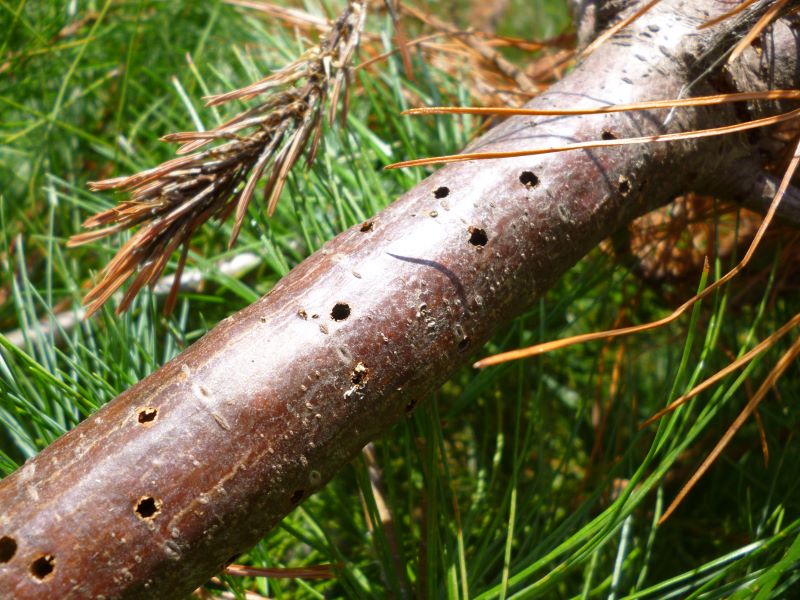
White pine weevil adult emergence holes in terminal leader. Too late to control by pruning out the leader. (Photo Credit: Steven K. Rettke, Rutgers Coop. Ext.)
Cicada Killer Wasps: These large, yellow, and black wasps resemble hornets & can be seen starting in late July through August & into September. Usually found nesting in the ground, the female wasps will prey on annual (“dog-day”) cicadas and drag them into their underground tunnels as food for their young. While the female searches for prey, the male wasp guards the nest. Males are aggressive but cannot sting since they do not have an ovipositor (stinger).
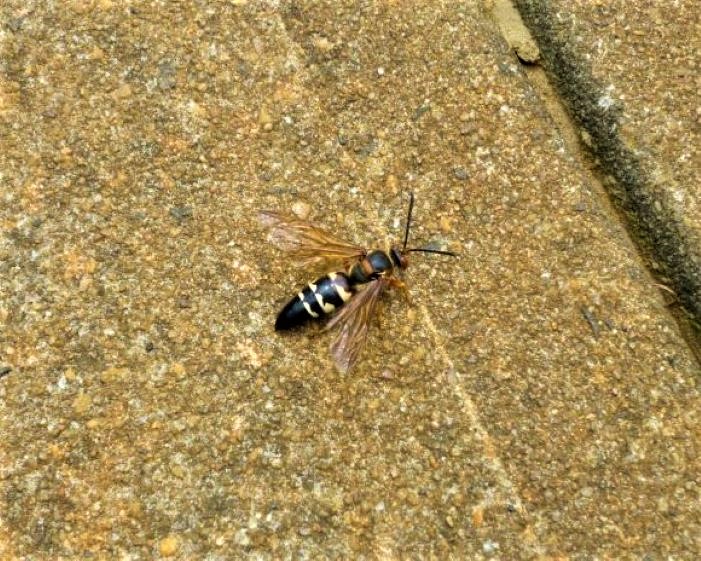
Cicada killer wasps are excellent predators against the “dog-day” annual cicadas. Although intimidatingly large, they rarely sting people. (Photo Credit: Steven K. Rettke, Rutgers Coop. Ext.)
Tolerate these if possible. They are useful predators & help keep the populations of annual cicadas at manageable levels. Large numbers nesting in one area can be damaging to turf, particularly on banks or near access areas. When necessary, controls can be achieved by applying Sevin dust (or granules) at dusk to the entry holes.
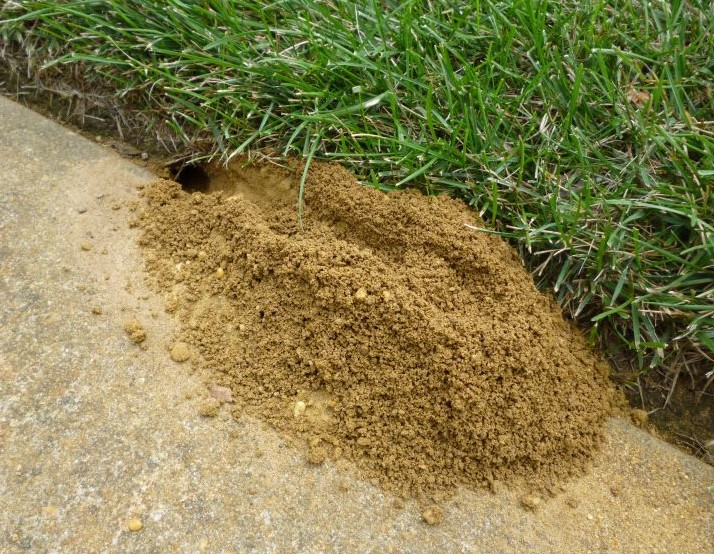
Cicada killer wasp females will drag paralyzed annual cicadas into underground nest entrance hole. Once inside nest, the cicada killer larvae will feed on them. (Photo Credit: Steven K. Rettke, Rutgers Coop. Ext.)

